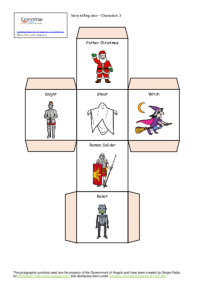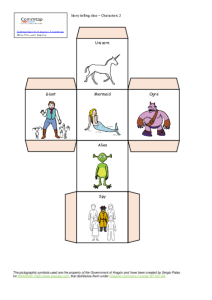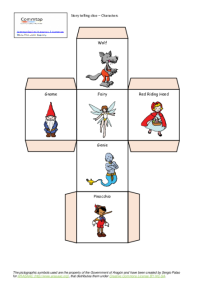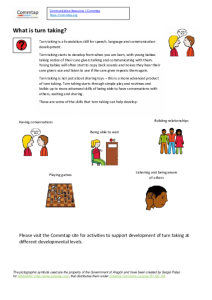Search
User login
Topic “Turn taking”
Story Telling Dice
This page contains printable story telling dice.
Story Telling Dice
Places Dice
Objects Dice
Characters Dice
Topic Themed Dice
Barrier game ideas
Barriers
Create a barrier so one person cannot see what the other person is doing. You could:
- Use a large hardback book
- Use two single fold files, stapled together to make a Π shape
- Use a ring binder (empty)
- Seat children back-to-back (only really suitable for paired work)
Games
Set of cards
Activities to develop early turn taking skills
| Activity/strategy name and materials required | How to do the activity | Key principles for doing the activity and comments |
|---|---|---|
| Ball Roll - a ball |
| To extend this activity, you could add extra people to roll the ball to (small group).
|
Developing turn taking using sensory toys
| Activity/strategy name and materials required | How to do the activity | Key principles for doing the activity and comments |
|---|---|---|
| Sensory Suitcase Use a small box or bag to collect toys which target different sensory areas e.g. Auditory (noisy toys) toys (rattles, squeakers, shakers, musical items, drums etc.) Visual toys (flags, streamers, Slinkies, spinners, bubbles, flashing items, torches, pop-up toys, windmills etc.) Tactile toys (toys that feel different) (balls of different textures to squeeze, brushes of different textures to be tickled with, materials e.g. velvet, sandpaper, feathers, pots of rice/macaroni to feel, Play dough to squeeze/cut ) Scented toys (play dough, Plasticine, some rubber toys) | 1. Collect some toys from each of the sensory categories described. 2. Store the toys in a container which you use only for this specific activity and is otherwise stored away from children. 3. Find a quiet comfortable place to work either at a table or on the floor. Try to make sure the child cannot easily run off or get distracted. 4. Make a show of shaking the suitcase and seeming happy about the approaching activity. 5. Take out two toys from different sensory categories and place them in front of the child - note which category of item the child chooses/reaches for and put the other item back in the suitcase. 6. Allow the child a short time to enjoy the item chosen then say 'Your name's turn' (e.g. "Mary's turn") and gently but firmly take the item for your turn. 7. Use the toy for a short time then offer it the child again. Say 'Child's name's turn'. 8. Repeat a few times but stop before the child gets bored. 9. Start the process again by offering the child a choice of toys from two different sensory categories and then follow the turn taking routine. 10. Continue with the activity for approximately 10 minutes - stop before the child gets bored. 11. Store the sensory suitcase in a secure place until the next session.
| These activities are based on a child's sensory preferences. Some children love visual toys but are frightened of noisy (auditory) toys. Accept these preferences and work with the sensory areas the child is comfortable with. Some children will choose some kinds of noisy toys and reject others or show fear when presented with others. Some children are frightened of feathers but love being tickled with a shaving brush. Experiment and observe! Sensory preferences can change over time as well! Keep the activity fun and show that you are enjoying it too! Make the activity time limited so that it stays special. Do the activity regularly and change the items used from time to time. |
| Create Colourful Patterns Use a selection of the following: Paint pots and brushes, felt tips, computer painting programme, pots with different coloured bits of paper to stick and a sheet of paper. | ||
| Messy Play Use, for example, one of the following sets of items: Sand tray with spades, pots etc. Water tray with pots, sieves, pourers etc Rice tray with pots and pourers etc |
To take turns and interact in a group
| Activity/strategy name and materials required | How to do the activity | Key principles for doing the activity and comments |
|---|---|---|
| Structured snack activity | Sit 2/3 children round a table Prepare the things to eat in advance e.g. biscuits on a plate broken into small bits and juice and mugs near to hand. Offer the child the plate of biscuits and support taking one piece only. Say 'Good choosing'. Move onto next child. Follow same routine for drinks. | Give only small portions to get the maximum number of interactions before the supply of food and drink runs out. Keep the pace speedy during this activity so that children do not get too desperate for the food. Initially support the child to take only one piece of biscuit and fade the support over time. Keep a watchful eye for the child taking extra turns! Reward desired behaviour with social praise. |
| Shared toys Fun toys | Choose high interest toys. Keep the pace of the activity snappy so children don't loose interest. Keep each child's turn short so children don't get impatient. | |
| Banging on a drum Drum | Keep the activity snappy and turns short. Use lots of social praise for behaviour you want. Use a drum that you bang with a hand not a beater. |
To be able to display and interpret different emotions
| Activity/strategy name and materials required | How to do the activity | Key principles for doing the activity and comments |
|---|---|---|
| Emotions game Group game for a minimum of three people
| 1. Shuffle the emotions cards and put one face up in each of the spaces on the 1-6 grid. 2. Check the children/young person know what each card says and what the emotion is (remove any that are too difficult and put new cards in their place). 3. Let everyone choose a coloured counter. Everyone puts one of their counters on the “start”. 4. Choose one person to start (perhaps the adult should go first). 5. The person who starts shakes the dice in the cup, and puts the cup upside down on the table. Carefully lift up the cup and look at the dice so only you know which number is on top. Look at the emotions cards on the board to see which emotion corresponds to the number on the dice – but don’t say what it is. 6. Pick a phrase card. Read the phrase on the card, displaying the emotion you have been given. Use your voice and gestures. It’s fine to give children help in reading what the phrase is, but not in how to display the emotion! 7. The other players watch the player acting out the emotion. They decide which of the emotions the player is portraying. They put their other counter on the name of the emotion they have chosen. 8. When everyone has voted, the player who acted the emotion lifts up the cup to show which number was on the dice. 9. Check to see who chose the correct emotion. The people who chose correctly move their counter on to the next space 10. The player who acted also moves their counter on the same number of orange spaces as the number of people who guessed correctly. 11. The next player then has a turn to act. Continue until someone has reached the “finish” space. | This game rewards your child/young person for doing good acting as well as good interpreting; therefore, there is an incentive to display the emotion correctly. Using the coloured counters to "vote" for an emotion prevents people from changing their mind. If the game takes too long to play, use only the orange spaces on the board. |
Plays games using dice
| Activity/strategy name and materials required | How to do the activity | Key principles for doing the activity and comments |
|---|---|---|
| Basic board games with simple dice Larger home-made die with the following on the sides:
Simple board games (probably best to be home made so they can be simple and adapted to meet your needs e.g. reinforce the colours being taught etc). | 1. Take it in turn to roll a die. 2. Count the spots on the side that faces up. 3. Repeat the number a few times - 'ok, you go 3. Number 3; let's count 3 places...' 4. Move the counter forward 3 places, counting each square. 5. Roll again etc. | Repetition Count each spot/square by touching it with your finger Extension activity: each square could be one of 3 colours. When you land on a red square you choose a card from the red pile... so vocabulary or sight words etc. could be targeted too. |
| Counting actions Action Cards - clapping, jumping, nodding, stand up; Simple die (as above). |
Building story telling/narrative skills using visual aids
| Activity/strategy name and materials required | How to do the activity | Key principles for doing the activity and comments |
|---|---|---|
| Story Lines - Washing line - Pegs - Selection of pictures | 1. Peg a picture on the line and ask your child to look at it - you could ask you child to choose a picture from a selection. 2. The adult says "It's story time and we are going to make up a story with the pictures" The adult starts the story by using the word on the picture. 3. Encourage your child to take the next turn by choosing a new picture and thinking how they can add to the story that has already been started. 4. Keep going until all the pictures have been used, or the story comes to a natural end. | This activity can be carried out with a small group of children You may need to recap the story at each turn, or give options if your child is finding it challenging to know what they can add. You could use a familiar story and use pictures from the book pegged to the line - you could encourage your child to retell the story with the pictures.
|
| Story Dice | This activity can be carried out with a small group of children You may need to recap the story at each turn, or give options if your child is finding it challenging to know what they can add. |
Support Commtap to keep it online
Thank you for visiting Commtap.
Please read this message as it is extremely important.
- Visitor donations mean we can continue to host over 1,000 free activities to support speech, language, and communication development.
- Visitor donations mean we can continue to provide free resources to address a wide range of communication needs, including limited speech or language, interaction challenges, and needs associated with conditions such as developmental language disorder, autism, and cerebral palsy.
- Visitor donations mean we can continue to provide resources to support the work of speech and language therapists, teachers, teaching assistants, parents, and carers.
- Visitor donations mean we can continue to provide the free key word sign dictionary (bks.org.uk) which has over 2,000 Makaton and Signalong signs.
We know that not everyone is able to afford to pay to access these resources, however, if you can, please make a donation to keep the site going.
Thank you
Google ads on this page are provided by Google Adsense - and their presence does not imply any endorsement by Commtap. Report a problem with an ad on this page. Log in (for free) to avoid seeing Google ads.








